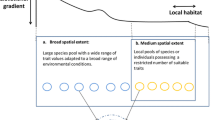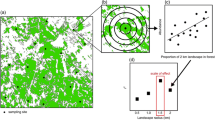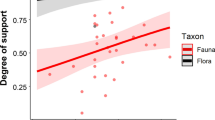Abstract
Purpose of Review
Species at a site interact with environmental variables of the surrounding landscape, but the spatial extent (scale) at which such interaction is strongest (“scale of effect,” SOE) varies among species. SOE is hypothesized to be driven mainly by species’ mobility, as a more mobile species should interact with environmental variables across larger scales. Yet, previous reviews found little evidence for this expectation. This may be because the actual SOE is often outside the assessed range of scales, as suggested by the fact that the estimated SOE frequently equals the smallest or largest scale investigated. We conducted a systematic review of studies published during the last decade to assess whether SOE can be predicted by mobility-related species traits. We controlled for the effects of several study attributes, and repeated all analyses excluding the SOE values that equaled the smallest or largest scales investigated.
Recent Findings
We found 70 studies reporting 1059 SOE values for 291 species, but ~ 50% of SOE values were not scale sensitive. SOE was weakly related to six mobility-related traits, independently of the taxonomic group, especially after controlling for study attributes. They remained weak after excluding the SOE values that equaled the smallest or largest scales investigated.
Summary
Our results imply that SOE cannot be predicted a priori from mobility-related traits. Therefore, we suggest that multi-scale analyses covering a wide range of scales should become standard practice to ensure we are not missing landscape context effects due to studying them at the wrong scale.




Similar content being viewed by others
References
Papers of particular interest, published recently, have been highlighted as: • Of importance •• Of major importance
Wiens JA. Spatial scaling in ecology. Funct Ecol. 1989;3:385–97.
Holland JD, Bert DG, Fahrig L. Determining the spatial scale of species’ response to habitat. Bioscience. 2004;54:227–33.
•• Jackson HB, Fahrig L. Are ecologists conducting research at the optimal scale? Glob. Ecol. Biogeogr. 2015;24:52–63. This is the most important and comprehensive previous review of the effect of species traits on the scale of landscape effect.
Stuber EF, Fontaine JJ. How characteristic is the species characteristic selection scale? Glob Ecol Biogeogr. 2019;28:1839–54.
Fahrig L. Rethinking patch size and isolation effects: the habitat amount hypothesis. J Biogeogr. 2013;40:1649–63.
•• Miguet P, Jackson HB, Jackson ND, Martin AE, Fahrig L. What determines the spatial extent of landscape effects on species? Landscape Ecol. 2016;31:1177–94. This paper assesses major theoretical models on the main drivers of the scale of landscape effect.
•• Martin AE. The spatial scale of a species’ response to the landscape context depends on which biological response you measure. Curr Landscape Ecol Rep. 2018;3:23–33. This is the more comprehensive review of empirical evidence on the effect of species’ responses on the scale of landscape effects.
• Crouzeilles R, Curran M. Which landscape size best predicts the influence of forest cover on restoration success? A global meta-analysis on the scale of effect. J. Appl. Ecol. 2016;53(2):440–448. This article provides an excellent meta-analysis on the scale of effect of landscape forest cover on restoration success.
Moraga A, Martin AE, Fahrig L. The scale of effect of landscape context varies with the species’ response variable measured. Landscape Ecol. 2019;34:703–15.
• Jackson HB, Fahrig L. What size is a biologically relevant landscape? Landsc Ecol. 2012;27:929–41. An excellent modeling study on the effect of species mobility on the scale of effect.
Ricci B, Franck P, Valantin-Morison M, Bohan DA, Lavigne. Do species population parameters and landscape characteristics affect the relationship between local population abundance and surrounding habitat amount? Ecol Complex. 2013;15:62–70.
Melo GL, Sponshiado J, Cáceras N, Fahrig L. Testing the habitat amount hypothesis for South American small mammals. Biol Conserv. 2017;209:304–14.
Brennan JM, Bender DJ, Contreras TA, Fahrig L. Focal patch landscape studies for wildlife management: optimizing sampling effort across scales. In: Liu J, Taylor WW, editors. Integrating landscape ecology into natural resource management. Cambridge: Cambridge University Press; 2002. p. 68–91.
Bowman J, Jaeger JAG, Fahrig L. Dispersal distance of mammals proportional to home range size. Ecology. 2002;83:2049–55.
Bowman J. Is dispersal distance of birds proportional to territory size? Can J Zool. 2003;81:195–202.
Holland JD, Fahrig L, Cappuccino N. Body size affects the spatial scale of habitat-beetle interactions. Oikos. 2005;110:101–8.
Jenkins DG, Brescacin CR, Duxbury CV, Elliott JA, Evans JA, Grablow KR, Hillegass M, Lyon BN, Metzger GA, Olandese ML, Pepe D, Silvers GA, Suresch HN, Thompson TN, Trexler CM, Williams GE, Williams NC, Williams SE. Does size matter for dispersal distance? Glob Ecol Biogeogr. 2007;16:415–25.
Tucker MA, Böhning-Gaese K, Fagan WF, Fryxell JM, Moorter BV, Alberts SC. Moving in the Anthropocene: global reductions in terrestrial mammalian movements. Science. 2018;359:466–9.
Hendriks AJ, Willers BJC, Lenders HJR, Leuven RSEW. Towards a coherent allometric framework for individual home ranges, key population patches and geographic ranges. Ecography. 2009;32:929–42.
Stevens GC. The latitudinal gradients in geographical range: how so many species co-exist in the tropics. Am Nat. 1989;133:240–56.
Fahrig L. Non-optimal animal movement in human-altered landscapes. Funct Ecol. 2007;21:1003–15.
Burt WH. Territoriality and home range concepts as applied to mammals. J Mammal. 1943;24:346–52.
Börger L, Dalziel BD, Fryxell JM. Are there general mechanisms of animal home range behaviour? A review and prospects for future research. Ecol Lett. 2008;11:637–50.
Brown JL, Orians GH. Spacing patterns in mobile animals. Annu Rev Ecol Syst. 1970;1:239–62.
Grant JWA, Champan CA, Richardson KS. Defended versus undefended home range size of carnivores, ungulates and primates. Behav Ecol Sociobiol. 1992;31:149–61.
Bates D, Maechler M, Bolker B, Walker S, Christensen RHB, Singmann H, Dai B, Scheipl F, Grothendieck G, Green P, Fox J, Bauer A, Krivitsky PN. Package ‘lme4’. CRAN repository. 2022. https://cran.r-project.org/web/packages/lme4/lme4.pdf. Accessed 1 July 2022.
Pinheiro JC, Bates DM. Mixed-effects models in S and S-Plus. 1st ed. New York: Statistics and Computing. Springer; 2000.
Barton K. MuMIn: Multi-model inference. CRAN repository. 2022. https://cran.r-project.org/web/packages/MuMIn/MuMIn.pdf. Accessed 1 July 2022.
Lenth R. Package ‘lsmeans’. CRAN repository. 2018. https://cran.r-project.org/web/packages/lsmeans/lsmeans.pdf. Accessed 1 July 2022.
Reich PB, Wright IJ, Cavender-Bares J, Craine JM, Oleksyn J, Westoby M, Walters MB. The evolution of plant functional variation: traits, spectra, and strategies. Int J Plant Sci. 2003;164:S143–64.
Römermann C, Bucher SF, Hahn M, Bernhardt-Römermann M. Plant functional traits – fixed facts or variable depending on the season? Folia Geobot. 2016;51:143–59.
Moretti M, Dias ATC, de Bello F, Altermatt F, Chown SL, Azcárate FM, Bell JR, Fournier B, Hedde M, Hortal J, Ibanez S, Öckinger E, Sousa JP, Ellers J, Berg MP. Handbook of protocols for standardized measurement of terrestrial invertebrate functional traits. Funct Ecol. 2017;31:558–67.
Milton K. Habitat diet, and activity patterns of free-ranging woolly spider monkeys (Brachyteles arachnoides E. Geoffroyi, 1806). Int J Primatol 1984;5:491–514.
Wrangham RW, Gittleman JL, Chapman CA. Constraints on group size in primates and carnivores: population density and day-range as assays of exploitation competition. Behav Ecol Sociobiol. 1993;32:199–209.
Chapman CA, Wrangham RW, Chapman LJ. Ecological constraints on group size: an analysis of spider monkey and chimpanzee subgroups. Behav Ecol Sociobiol. 1995;36:59–70.
Campera M, Serra V, Balestri M, Barresi M, Ravaolahy M, Randriatafika F, Donati G. Effects of habitat quality and seasonality on ranging patterns of Collared Brown lemur (Eulemur collaris) in littoral forest fragments. Int J Primatol. 2014;35:957–75.
Cristóbal-Azkarate J, Arroyo-Rodríguez V. Diet and activity pattern of howler monkeys (Alouatta palliata) in Los Tuxtlas, Mexico: effects of habitat fragmentation and implications for conservation. Am J Primatol. 2007;69:1013–29.
Leal-Ramos D, Pizo MA, Ribeiro MC, Cruz RS, Morales JM, Ovaskainen O. Forest and connectivity loss drive changes in movement behavior of bird species. Ecography. 2020;43:1203–14. https://doi.org/10.1111/ecog.04888.
Galán-Acedo C, Arroyo-Rodríguez V, Arasa-Gisbert R, Andresen E. Ecological traits of the world’s primates. Sci Data. 2019;6:55. https://doi.org/10.1038/s41597-019-0059-9.
May R, van Dijk J, Landa A, Andersen R, Andersen R. Spatio-temporal ranging behaviour and its relevance to foraging strategies in wide-ranging wolverines. Ecol Mod. 2010;221:936–43.
Garnier E, Laurent G, Bellmann A, Debain S, Berthelier P, Ducout B, Roumet C, Navas ML. Consistency of species ranking based on functional leaf traits. New Phytol. 2001;152:69–83.
Galán-Acedo C, Arroyo-Rodríguez V, Estrada A, Ramos-Fernández G. Drivers of the spatial scale that best predict primate responses to landscape structure. Ecography. 2018;41:2027–37.
Martínez-Ruiz M, Arroyo-Rodríguez V, Franch I, Renton K. Patterns and drivers of the scale of landscape effect on diurnal raptors in a fragmented tropical dry forest. Landscape Ecol. 2020;35:1309–22.
Cudney-Valenzuela SJ, Arroyo-Rodríguez V, Andresen E, Toledo-Aceve T. What determines the scale of landscape effect on tropical arboreal mammals? Landsc Ecol. 2022;37:1497–507.
Jackson ND, Fahrig L. Landscape context affects genetic diversity at a much larger spatial extent than population abundance. Ecology. 2014;95:871–81.
Acknowledgements
We thank A. Martin for the invitation for writing this paper and two anonymous reviewers for their constructive comments. MM-R thanks the Dirección General de Asuntos del Personal Académico (DGAPA)-UNAM for a postdoctoral scholarship. CG-A received a postdoctoral scholarship from the Natural Sciences and Engineering Research Council of Canada (NSERC).
Author information
Authors and Affiliations
Corresponding author
Ethics declarations
Conflict of Interest
Víctor Arroyo-Rodríguez, Marisela Martínez-Ruiz, Jakelyne S. Bezerra, Carmen Galán-Acedo, Miriam San-José, and Lenore Fahrig declare that they have no conflict of interest.
Human and Animal Rights and Informed Consent
This article does not contain any studies with human or animal subjects performed by any of the authors.
Additional information
Publisher's Note
Springer Nature remains neutral with regard to jurisdictional claims in published maps and institutional affiliations.
Topical Collection on Scale-Measurement, Influence, and Integration
Supplementary Information
Below is the link to the electronic supplementary material.
Rights and permissions
Springer Nature or its licensor (e.g. a society or other partner) holds exclusive rights to this article under a publishing agreement with the author(s) or other rightsholder(s); author self-archiving of the accepted manuscript version of this article is solely governed by the terms of such publishing agreement and applicable law.
About this article
Cite this article
Arroyo-Rodríguez, V., Martínez-Ruiz, M., Bezerra, J.S. et al. Does a Species’ Mobility Determine the Scale at Which It Is Influenced by the Surrounding Landscape Pattern?. Curr Landscape Ecol Rep 8, 23–33 (2023). https://doi.org/10.1007/s40823-022-00082-7
Accepted:
Published:
Issue Date:
DOI: https://doi.org/10.1007/s40823-022-00082-7




